The XR Fair Tokyo was smaller and (a bit) less wild than I expected! I am probably biased by the academic/R&D companies that usually present out of the box (sometimes delirious) projects when coming to European events like Laval Virtual.
Around 70+ booths, some of them being country pavilions gathering several companies, were demonstrating AR/VR solutions. Surprisingly, unlike the last shows I visited, AI was barely advertised and even if used in solutions, AR/VR was at the forefront of every booth.
There were various nationalities exhibiting, mainly from Asian countries; Taiwan and Korea had even their own pavilions, as well as … Poland!
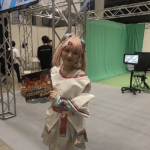
The attendance was rather middle aged, with some groups of students. According to all exhibitors I spoke to, the audience was highly qualified, and discussions business orientated, making the show worthwhile, even if the XR fair was not large.
You could not forget though that you were at a Japanese event: the “imagery” used for avatars creation, demonstrations, or promotion was often using manga style representations, kawaii characters or young girls’ anime. As an example, through a voice application a middle-aged guy was engaging aloud with visitors with a female manga style teenager’s voice (weird as hell!). And pretty much everything was written/explained/demonstrated in Japanese…
Looking at XR content and solutions demonstrated,
it confirmed that XR entered some kind of global maturity. Use cases and addressed sectors were similar to Europe/USA:
- Training solutions for different sectors (medical, industrial)
- Remote assistance, Engineering design for the industrial sector
- Virtual try-on, promotion, and advertising for retail
- Culture with augmented visits
Solutions presented were close to what we create in Europe, i.e. AR Works developing a wide array of AR applications for retail or cultural places, or Digi space from Taiwan, with multiple experiences in marketing AR, focusing on activation and data .
Most companies however were not startups but for most established firms for years, such as Berise that started back in 2012 and have 50+ employees working on XR projects.
Some “metaverse” solutions were promoted, and again on very similar cases we encounter in western part of the world : Up-frontier, for example, was displaying through Apple Vision Pro and Magic Leap an AR representation of a whole city, with the visualisation of impacts of a flood or other events in real time.
Overall, very customers orientated offering, with a focus on data, ROI, use case value, again demonstrating a certain market maturity. The visitors seemed in general quite knowledgeable and came with projects in mind, leading to more business orientated discussions than basic acculturation.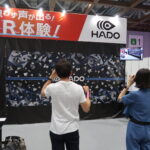
Along the alleys, I met again bHaptics, featuring their (large) range of haptics devices (vest, gloves, armbands, feet bands…), and I had a quite extensive discussion with the well-known Swedish eye tracking company Tobii, that came to Japan to promote their cold lens-casting manufacturing solution to produce lenses for AR/VR devices and eyewear. And I interviewed the company Meleap, that I will cover in a separate post, as I love the concept.
In terms of XR hardware,
the difference was that smartglasses/headsets are not considered as the only platform for XR.
Of course, several VR headsets were demonstrated at XR Fair Tokyo, and Meta Quest was widely present across booths, as well as a few Apple Vision Pro and Magic Leap glasses. Lenovo, Xreal with Xreal Ultra (delivered from August in Europe), Skyworth, Goovis and Toall (met at Vivatech, refer to previous blog) had their own booth.
Lenovo surprisingly was demonstrating in AR the Swiss solution Sphere and in VR the French Uptale one! (Proud of our European XR fellows).
Skyworth, a Chinese group worth $7+ billion, featured their VR and AR glasses, offering flexible production and OEM services. It reminded me that the number of smartglasses, especially from China (may they be classified as AR glasses, AI glasses, secondary displays…) is just exploding and we can witness new brands coming up with models at every event now. For the best hopefully as the competition pushes the biggest manufacturers to innovate.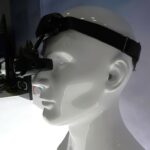
Goovis, that has been around for some time now with light VR headsets used for entertainment, was launching its Indiegogo campaign for its new “AR passthrough” model, ART; 110gr, comfortable, good image quality, IPD adjustment, it is a different concept as a secondary display.
But other hardware platforms were displayed such as entire ranges of 3D screens and holographic displays like Asukanet, promoting their “aerial gaming” and “walk through wall signage”; or projectors with interactive capabilities, such as East West that provides different usages of AR in retail for example.
Various simulators were available as well on the booths as SIM G supplying top of the range heavy equipment training simulators, while some other company proposed to have a 360-degree looping with a VR headset on!
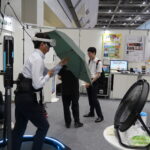 You could not miss however the hardware simulator that makes you walk against wind and rain while wearing your VR headset (and holding an actual umbrella!)
You could not miss however the hardware simulator that makes you walk against wind and rain while wearing your VR headset (and holding an actual umbrella!)
At the end
What I found insightful is that the “XR fair Tokyo” was only a part of a bigger show, “Content Tokyo”; interestingly there were on the same floor several other exhibitions, complementary and all connected: “Advanced digital expo”, “Video & CG production expo”, and “Ad & Creative & Marketing Expo” were all demonstrating services and solutions that are very interesting to consider as complementary to XR technologies.
On an upper floor, you could access as well the “Creators expo,” with hundreds of very talented 2D artists and illustrators; they all presented their creations on tiny booths, set next to each other, showing an amazing palette of colourful and creative designs.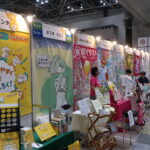
And finally (to close the loop?), another event on the same floor “Licensing Japan” was showcasing licenses owned by Japanese medium size to large companies such as Bandai, Namco or Sony.
Alongside XR Fair Tokyo I found smart to have a panel of different offers complementing each other, while being segregated by theme in case the visitor is just interested in one topic (all the exhibitions could be accessed with same or different badges, and all free of charge). Maybe something to consider for XR events in Europe, often operated as standalone, which could benefit from synergies?
